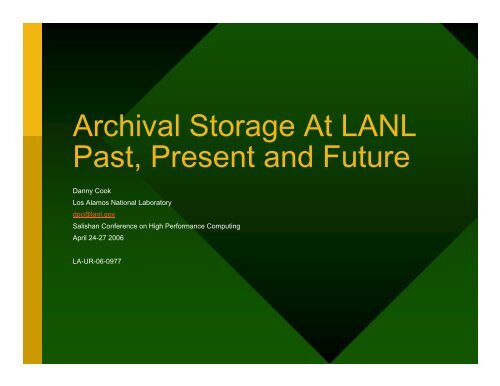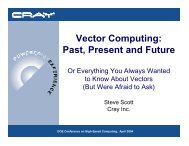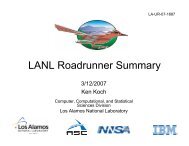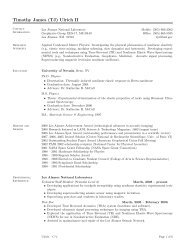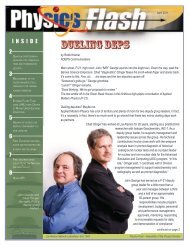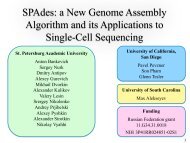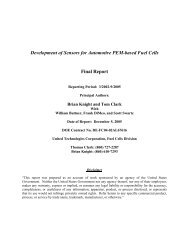Archival Storage At LANL Past, Present and Future - Los Alamos ...
Archival Storage At LANL Past, Present and Future - Los Alamos ...
Archival Storage At LANL Past, Present and Future - Los Alamos ...
Create successful ePaper yourself
Turn your PDF publications into a flip-book with our unique Google optimized e-Paper software.
<strong>Archival</strong> <strong>Storage</strong> <strong>At</strong> <strong>LANL</strong><br />
<strong>Past</strong>, <strong>Present</strong> <strong>and</strong> <strong>Future</strong><br />
Danny Cook<br />
<strong>Los</strong> <strong>Alamos</strong> National Laboratory<br />
dpc@lanl.gov<br />
Salishan Conference on High Performance Computing<br />
April 24-27 2006<br />
LA-UR-06-0977
Main points of presentation<br />
• Brief history of archival storage at <strong>LANL</strong>.<br />
• More detailed history of HPSS with focus<br />
on how HPSS has been used at <strong>LANL</strong><br />
• Discuss <strong>LANL</strong> future in archival storage.
HSM: Hierarchical storage management<br />
• Purposes of HSM:<br />
– Extend file system space<br />
– Back up disk files to tape<br />
– Manage permanent archive<br />
• Can be integrated with file system or usage of an archival<br />
utility.<br />
– Data migrates “down” the hierarchy<br />
– Migrated files may be asynchronously purged from<br />
higher level (e.g. disk) to free up space<br />
• Multiple classes of service in a single name space, for<br />
example<br />
– Disk to tape<br />
– Tape only<br />
– High speed disk to low-cost disk to MAID to tape library<br />
to shelf tape<br />
Archive front<br />
end<br />
disk<br />
robotic tape<br />
shelf tape<br />
data
Archives Provide<br />
• Machine/file system agnostic storage solution<br />
• The most cost effective storage<br />
• Long-term data stewardship<br />
– Protection of billions of dollars of data investment<br />
– Outlives vendors, machines, operating systems, file systems<br />
– Protection from platform disasters (software or hardware)<br />
– Repack <strong>and</strong> data rescue tools<br />
– Multiple copies<br />
• Risk-averse solutions not tied to “latest” changes (OS releases) on platforms<br />
• Scales larger than most file systems - #files, directories, file sizes<br />
• Intelligent resource usage/data placement<br />
– Classes Of Service,<br />
– Stage/migrate/purge<br />
• Robotic/atomic mounts of sequential media<br />
• Access to devices that have long inherent delays
Tape is much less expensive<br />
• In LLNL environment tape is:<br />
– 6.7 times cheaper to purchase (including drives, robotics, movers<br />
<strong>and</strong> media).<br />
– 56.7 times cheaper than disk for yearly maintenance<br />
– 342 times cheaper than disk for electrical power<br />
– 342 times cheaper for cooling<br />
– 72 times cheaper net yearly upkeep
Architectural Tradeoffs<br />
• Removable media reuses I/O infrastructure<br />
– When disk is full the pipes connecting it go dark.<br />
– When a tape is full another tape uses its I/O infrastructure<br />
• Tape can be used across multiple generations<br />
– Our media typically serves 2-3 generations of tape drives<br />
• Removable media allows greater scaling freedom<br />
– One can more easily buy capacity or performance as<br />
needed with removable devices.<br />
But we can’t forget that Disk is r<strong>and</strong>om access, fast <strong>and</strong><br />
easily RAIDed.
• <strong>LANL</strong> has been involved in archival<br />
storage since at least the late 1970s.<br />
• Systems in use at <strong>LANL</strong><br />
– IBM Photostore<br />
– Common File System(CFS)<br />
– High Performance Data System(HPDS)<br />
– High Performance <strong>Storage</strong> System(HPSS)
Common File System<br />
• Development began in 1979<br />
• Deployed in 1981<br />
• MVS/IBM mainframe based<br />
• Primary archival storage system at <strong>LANL</strong><br />
until 1997.<br />
• All data converted to HPSS in 2001.
Common File System<br />
• HSM based on disk, IBM 3850 <strong>and</strong> various tape<br />
technologies.<br />
• Network centered, non distributed.<br />
• Highly reliable, robust. Unique features such as<br />
User Validation Lists (better than ACLs).<br />
• Limitations in terms of scalability, performance,<br />
file size.<br />
• <strong>At</strong> time of conversion to HPSS, 10 million files,<br />
app. 110 TB of data.
High Performance Data System<br />
• Developed, deployed 1991-1992<br />
• Unix based, distributed model running on<br />
workstation class machines.<br />
• Primary user was Connection Machine.<br />
• All data converted to HPSS in 1997.<br />
• Similar work at NSL(NSL Unitree) at LLNL.<br />
Some of the first efforts to separate control/data<br />
paths.
High Performance <strong>Storage</strong> System<br />
• Next generation HSM. Primary goals were performance<br />
<strong>and</strong> scalability.<br />
• Collaboration formed to focus on a common effort between<br />
LLNL <strong>and</strong> <strong>LANL</strong>.<br />
• Initial discussion began at Salishan in 1992.<br />
• Collaboration formed between <strong>LANL</strong>, LLNL, S<strong>and</strong>ia, Oak<br />
Ridge <strong>and</strong> IBM Federal Systems in 1993.<br />
• Design, development began in late 1993. First production<br />
system deployed at SDSC in 1996.<br />
• First <strong>LANL</strong> production system in 1997.
High Performance <strong>Storage</strong> System<br />
• HSM, network based, distributed model<br />
• Separation of data, control paths, parallel IO to tape <strong>and</strong><br />
disk.<br />
• Centralized metadata manager (initially Transarc SFS, now<br />
IBM DB2).<br />
• Security <strong>and</strong> distributed model based on DCE. Latest<br />
version removes DCE. Replaced with GSS model over<br />
Kerberos, UNIX <strong>and</strong> LDAP. RPC HPSS developed.<br />
• Scalability in name space (storage subsystems, DB2).
High Performance <strong>Storage</strong> System<br />
• Commercial offering from IBM Federal Systems<br />
in Houston.<br />
• Number of sites world wide running HPSS.<br />
• Sites include DOE labs, universities, weather<br />
centers, DOD facilities, foreign sites in France,<br />
Engl<strong>and</strong>, Japan, Korea. Currently about 50<br />
sites (classified <strong>and</strong> unclassified).
HPSS experience at <strong>LANL</strong><br />
• Deployed in 1997.<br />
• Scalability excellent. Has scaled from 3-5 TB growth per<br />
month in 1998 to over 300 TB month in 2006. Factor of<br />
100. HPSS ingests in one week what was stored in CFS in<br />
20 years.<br />
• Total storage in secure is at 5.5 PB <strong>and</strong> app. 55 million files.<br />
• Single file transfer rates have scaled from a max of<br />
60MB/sec in 1998 to 160MB/sec in 2006. With new<br />
Titanium drives should reach 600MB/sec. + in 2006. Rates<br />
are based on 4 way tape stripes. Larger stripes would give<br />
higher rates.<br />
• Currently, aggregate throughput limited by network. New<br />
10GigE switches will relieve this. Prior testing has<br />
demonstrated capability to scale to network b<strong>and</strong>width.
HPSS experience at <strong>LANL</strong><br />
• Very reliable, robust. Replacement of SFS with DB2 in<br />
HPSS 5.1 in 2004 has enhanced this.<br />
• HPSS 6.2 (available now) will eliminate DCE. Puts HPSS in<br />
a strong position to go forward into the future.<br />
• SFS database created problems on 3 occasions. Caused<br />
some downtime <strong>and</strong> a loss of a small number of files(100<br />
or so) on one occasion. Since replaced with DB2 in<br />
release HPSS 5.1 in 2004.<br />
• Microcode failure in one STK 9940B drive corrupted a<br />
small number of files.
HPSS Experience at <strong>LANL</strong><br />
• STK RAIT project in 1999-2001 did not result in deliverable.<br />
Prototype implementation successful, but STK decided not<br />
sufficient market.<br />
• STK SN6K with tape mirroring was not deployed due to<br />
performance issues.<br />
• <strong>Future</strong> for RAIT is likely client side software striping.<br />
• Currently, delayed secondary tape copies provide a form of<br />
mirroring.<br />
• Have seen some performance issues on small files related to<br />
some DB2 locking issues. Resolved in HPSS 6.2
HPSS <strong>Future</strong> at <strong>LANL</strong><br />
• Complete PSI/HTAR option. Currently in limited production by user. Semi-transparent<br />
bundling capabilities. Have demonstrated over 1 million small files/hour.<br />
• Deploy HPSS 6.2<br />
– Completes infrastructure replacement<br />
– NFS/VFS Linux<br />
– GPFS/DMAPI/HPSS (LBL,SDSC)<br />
• HPSS 7.1 development begins. (Summer or fall of 2007).<br />
– Increase small file performance with a target of a 5x increase. Initial investigations<br />
promising.<br />
– Add tape aggregation to increase migration performance Targeted part of small file<br />
performance enhancements.<br />
– Add client affinity to make the use of Local File Movers more usable.<br />
– Performance in other areas such as listing operations. Potential 10x improvement in<br />
listing performance.
• HPSS 8.1<br />
HPSS <strong>Future</strong> at <strong>LANL</strong><br />
– Primary focus is another order of scalability in total<br />
throughput. Also oriented towards small files.<br />
– Multiple core servers to distribute name space load.<br />
– Use partitioned capabilities of DB2 to distribute <strong>and</strong> get<br />
parallel performance improvements in metadata<br />
operations. Believe DB2 provides advantages here.<br />
– Possible client side caching with lease type lock<br />
management.<br />
– 2009 time frame.<br />
– Initial discussions begun but at very high level.
• Clients select Core<br />
Servers based on current<br />
load<br />
• File metadata is cached<br />
at the client <strong>and</strong> updated<br />
periodically, or when<br />
invalidated by a Core<br />
Server<br />
• Lease based locking is<br />
used to provide metadata<br />
cache coherency, unix file<br />
open semantics <strong>and</strong>, unix<br />
file range locking<br />
semantics
<strong>Future</strong> challenges for archival<br />
• Petascale computing will present new<br />
challenges.<br />
– Will require small file aggregate archival rates to be<br />
in the 1000 files/sec. + range.<br />
– Amount of data archived will grow by at least an<br />
order of magnitude. Has media cost implications.<br />
<strong>LANL</strong> currently spends about $70,000 month on<br />
tape media.<br />
– Will require advancements in both archival software<br />
<strong>and</strong> hardware.
<strong>Future</strong> challenges for archival<br />
• Projections for tape drive capacity <strong>and</strong> performance.<br />
– STK currently has the T10K at 120B/sec. <strong>and</strong> cartridge<br />
capacity of 500GB.<br />
– Tape industry projects capacity doubling every 2 years<br />
(16TB by 2015). Speed will ramp up slower. Should<br />
approach 1GB/sec around 2015.<br />
– Sony projects a 32TB helical scan cartridge in the 2011<br />
time frame.<br />
– Holographic storage now looking possible. Could compete<br />
with tape at some point.<br />
– Issue: Tape drive capacity may not scale as fast as<br />
needed for petascale archival.
<strong>Future</strong> challenges for archival<br />
• Software challenges<br />
– Small files. Need aggregate of 1000+ inserts/sec.<br />
Need tape aggregation. Plans for HPSS to do this.<br />
– Need a high degree of scalability in aggregate I/O<br />
b<strong>and</strong>width. HPSS has this.<br />
– Reliability/integrity still foremost requirement of an<br />
archive.<br />
– Possible dem<strong>and</strong>s for more transparency. Interest in<br />
integration with Panasas,Lustre <strong>and</strong> GPFS. HPSS<br />
integrates with GPFS with DMAPI.
<strong>Future</strong> challenges for archival<br />
• Alternatives for archival system<br />
- QSAM/Sam-FS primary competitor to HPSS. Some<br />
experience at one existing HPSS site(SDSC). Does<br />
not appear to be able to h<strong>and</strong>le the same load as<br />
HPSS.<br />
- SGI DMF not as easily scaled as HPSS. Evaluated<br />
approximately 2 years ago.<br />
- Object based file system(Lustre)/commercial HSM.<br />
Current research project at U. Minnesota<br />
- HPSS
Some conclusions<br />
• HPSS will be the archival storage system at <strong>LANL</strong> for at least the<br />
next 4-5 years. PSI/HTAR helps significantly with small file<br />
problem.<br />
• Modifications to HPSS in the areas of small file performance/tape<br />
aggregation/etc. can make it a viable c<strong>and</strong>idate for a much longer<br />
future.<br />
• Need to look at Lustre/HSM work at U. Minnesota in more detail.<br />
Currently a research project. Need to underst<strong>and</strong> if it is a<br />
practical approach that might be an archival alternative at some<br />
point in the future.<br />
• Need to take a look at the way archival systems are used.<br />
Petascale computing dem<strong>and</strong>s may require a more judicious use<br />
of archival storage due to storage costs.


